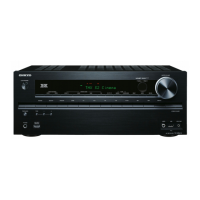Appendix
En-95
Network/USB Features
The following diagram shows how you can connect the AV
receiver to your home network. In this example, it’s
connected to a LAN port on a router, which has a 4-port
100Base-TX switch built-in.
■ Ethernet Network
For the best results, a 100Base-TX switched Ethernet
network is recommended. Although it’s possible to play
music on a computer that’s connected to the network
wirelessly, playback may be unreliable, so it is
recommended to use wired connections.
■ Ethernet Router
A router manages the network, data-routing and supplying
of IP addresses. Your router must support the following:
• NAT (Network Address Translation). NAT allows
several networked computers to access the Internet
simultaneously via a single Internet connection. The AV
receiver needs Internet access for Internet radio.
• DHCP (Dynamic Host Configuration Protocol). DHCP
supplies IP addresses to the network devices, allowing
them to configure themselves automatically.
• A router with a built-in 100Base-TX switch is
recommended.
Some routers have a built-in modem, and some Internet
Service Providers (ISP) require you to use specific routers.
Please consult your ISP or computer dealer if you’re
unsure.
■ CAT5 Ethernet cable
Use a shielded CAT5 Ethernet cable (straight-type) to
connect the AV receiver to your home network.
■ Internet Access (for Internet radio)
To receive Internet radio, your Ethernet network must have
Internet access. A narrowband Internet connection (e.g.,
56K modem, ISDN) will not provide satisfactory results,
so a broadband connection is strongly recommended (e.g.,
cable modem, xDSL modem, etc.). Please consult your ISP
or computer dealer if you’re unsure.
Note
• To receive Internet radio with the AV receiver, your broadband
Internet connection must be working and able to access the Web.
Consult your ISP if you have any problems with your Internet
connection.
• The AV receiver uses DHCP to configure its network settings
automatically. If you want to configure these settings manually,
see “Network” (➔ page 67).
• The AV receiver does not support PPPoE settings, so if you have
a PPPoE-type Internet connection, you must use a PPPoE-
compatible router.
• Depending on your ISP, you may need to specify a proxy server
to use Internet radio. If your computer is configured to use a
proxy server, use the same settings for the AV receiver
(➔ page 68).
Connecting to the Network
WAN
LAN
Modem
Router
Computer or media server
Internet radio
Network Requirements

